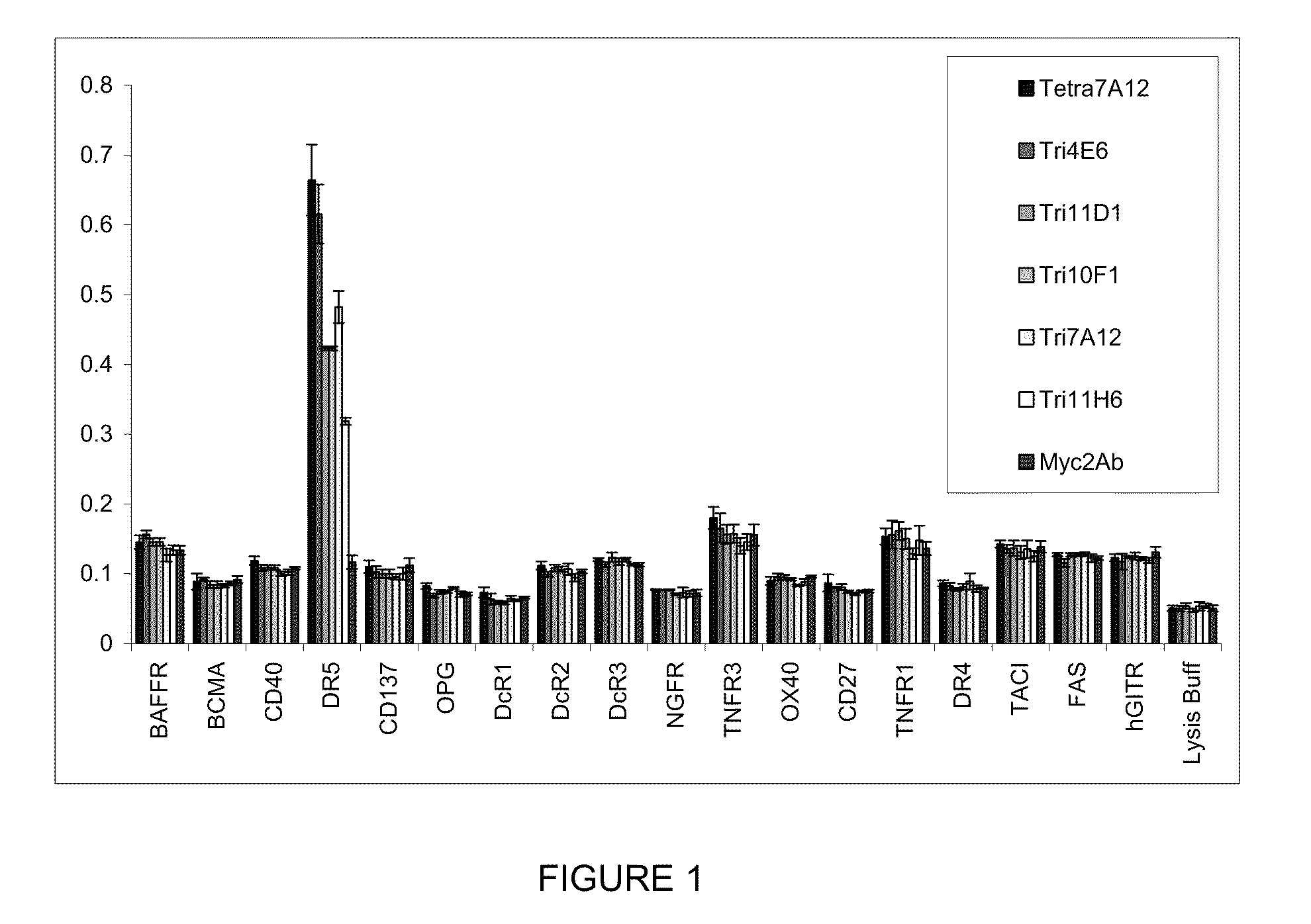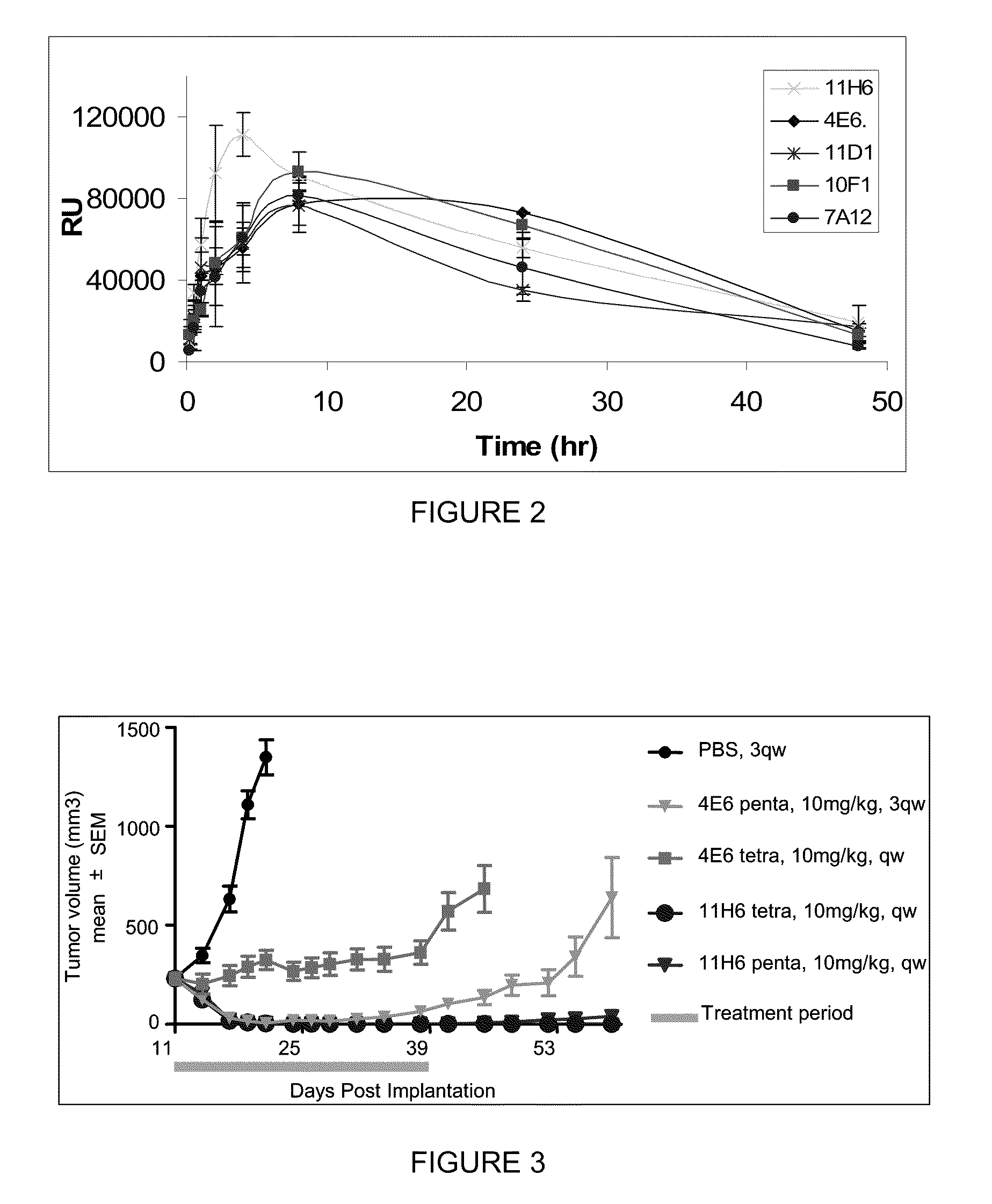Biologic compounds directed against death receptor 5
a technology of death receptor and biological compounds, applied in the direction of antibody medical ingredients, peptide/protein ingredients, depsipeptides, etc., can solve the problems of dr5 specific antibodies being developed for use, potential toxicity concerns, and none of them are yet approved, so as to increase or enhance signaling, increase the biological mechanisms, responses and effects associated
- Summary
- Abstract
- Description
- Claims
- Application Information
AI Technical Summary
Benefits of technology
Problems solved by technology
Method used
Image
Examples
example i
1. Example I
1.1. Human and Cyno DR5 Cloning and Protein Preparation
[0596]1.1.1. Cloning of Human Long Form DR5 Extracellular Domain (ECD) and Cyno Long and Short Form DR5 ECD
[0597]The human long form DR5 ECD (aa55-213) is cloned by RT-PCR. Total RNA are isolated from Jurkat and Raji cells by Qiagen's RNeasy mini Kit (Cat No. 74104). cDNA is made by the SuperScript II First Strand Synthesis System (Invitrogen, Cat: 11904-018) then are amplified by High Fidelity Platinum Taq DNA Polymerase (Invitrogen, Cat no. 11304-011) using standard protocol: 94° C. for 2 min followed by 30 cycles of 95° C. / 30 seconds, 55° C. / 30 seconds, 72° C. / 60 seconds and a final incubation at 72° C. for 7 min. The forward and reverse primers used for PCR are: 5′-CTGATCACCC AACAAGACCT AG-3′ (SEQ ID NO: 83) and 5′-GCCTGAGAGA GAACAGGGAG A-3′ (SEQ ID NO: 84) respectively. The resulting 476 by fragment is then ligated into E. coli expression vector pBAD / Thio-TOPO (Invitrogen, Cat No. K370-01). Positive clones are i...
example ii
2. Example II
2.1. Trimerization
[0619]DNA fragments encoding anti-DR5 NB constructs are digested with MfeI and BstEII and cloned into pAX73, pAX74 and pAX75 vectors in frame with linker sequences. These are transformed into TG-1 competent cells and kanamycin resistant clones are analyzed for the presence of insert and sequence verified. The resulting constructs are digested with SfiI, BpuAI and NotI and the NB construct containing fragments are then cloned through a four-point ligation into SfiI-NotI digested pAX51 vector. Positive carbenicillin resistant clones, i.e., those encoding trivalent CMYC-HIS6-tagged NB construct constructs (“HIS6” is disclosed as SEQ ID NO: 92) (each NB construct building block fused to the next by a linker sequence), are again sequence verified. pAX73, pAX74, pAX75 and pAX83 are pUC-derived cloning vectors that contain a resistance gene for kanamycin or neomycin, multicloning sites and in frame with the NB construct coding sequence, these vectors encode G...
example iii
3. Example III
3.1. Binding on Biacore
[0623]Biacore CM5 sensor chips are coated with short (182 amino acids) human DR5-Fc fusion protein (R&D Systems, Minneapolis Minn., catalogue #631-T2 / CF) or cynomolgus DR5-Fc fusion protein (amino acids 56 to 213, IgG1 NVTS). Different concentrations (1 to 100 nM) of monovalent and multivalent anti-DR5 NB constructs are then floated over the chips for a kinetic analysis of the binding interaction. All multivalent anti-DR5 NB constructs bind to human and cynomolgus DR5 (Table 9).
[0624]
TABLE 9Affinities (M) of anti-DR5 NB constructs asdetermined by surface plasmon resonanceHuman DR5Cynomolgus DR5CloneMonoTriTetraMonoTriTetra11D11.0 × 10−9−11ND2.2 × 10−7−10ND7A127.3 × 10−9−12ND7.1 × 10−9−11ND10F14.2 × 10−9−113.9 × 10−121.4 × 10−7−102.2 × 10−1111H66.7 × 10−9−10ND9.2 × 10−6−10ND4E61.7 × 10−10−11ND1.6 × 10−8−11NDND: Not determined;BDL: below detection limit
3.2. Binding on FACS
[0625]In another set of experiments, cell lines expressing human (Colo205) or...
PUM
| Property | Measurement | Unit |
|---|---|---|
| KA | aaaaa | aaaaa |
| KA | aaaaa | aaaaa |
| KA | aaaaa | aaaaa |
Abstract
Description
Claims
Application Information
 Login to View More
Login to View More - R&D
- Intellectual Property
- Life Sciences
- Materials
- Tech Scout
- Unparalleled Data Quality
- Higher Quality Content
- 60% Fewer Hallucinations
Browse by: Latest US Patents, China's latest patents, Technical Efficacy Thesaurus, Application Domain, Technology Topic, Popular Technical Reports.
© 2025 PatSnap. All rights reserved.Legal|Privacy policy|Modern Slavery Act Transparency Statement|Sitemap|About US| Contact US: help@patsnap.com



